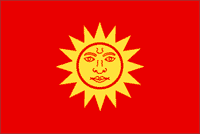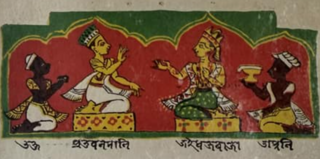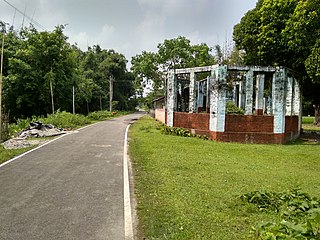
The Battle of Saraighat was a naval battle fought in 1671 between the Mughal Empire, and the Ahom Kingdom on the Brahmaputra river at Saraighat, now in Guwahati, Assam, India. The Ahoms, smarting from the occupation of the capital by Mir Jumla and the harsh conditions of Treaty of Ghilajharighat, decided to lure a Mughal imperial force to Saraighat and take a stand there. Although weaker, the Ahom Army defeated the Mughal Army by massive army, clever diplomatic negotiations to buy time, guerrilla tactics, psychological warfare, military intelligence and by exploiting the weakness of the Mughal forces—its navy.

Bongaigaon district (Prpn:ˈbɒŋgaɪˌgãʊ) is an administrative district in the state of Assam in northeastern India. The district headquarters are located at Bongaigaon. The district occupies an area of 1,093 km2.

Sonitpur district [Pron: ˌsə(ʊ)nɪtˈpʊə or ˌʃə(ʊ)nɪtˈpʊə] is an administrative district in the state of Assam in India. The district headquarters is located at Tezpur.

The Dooars or Duars are the alluvial floodplains in eastern-northeastern India that lie south of the outer foothills of the Himalayas and north of the Brahmaputra River basin. This region is about 30 km (19 mi) wide and stretches over about 350 km (220 mi) from the Teesta River in West Bengal to the Dhansiri River in Assam. The region forms the gateway to Bhutan. It is part of the Terai-Duar savanna and grasslands ecoregion.

The Koch dynasty ruled parts of eastern Indian subcontinent in present-day Assam and Bengal. Biswa Singha established power in the erstwhile Kamata Kingdom which had emerged from the decaying Kamarupa Kingdom. The dynasty came to power by removing the Baro-Bhuyans, who had earlier removed the short-lived rule established by Alauddin Hussain Shah.

The Kamata Kingdom emerged in western Kamarupa probably when Sandhya, a ruler of Kamarupanagara, moved his capital west to Kamatapur sometime after 1257 CE. Since it originated in the old seat of the Kamarupa kingdom, and since it covered most of the western parts of it, the kingdom is also sometimes called as Kamarupa-Kamata.

Susenghphaa or Pratap Singha, was the 17th and one of the most prominent kings of the Ahom kingdom. As he was advanced in years when he became king, he is also called the burha Raja. His reign saw an expansion of the Ahom kingdom to the west, the beginning of the Ahom-Mughal conflicts, and a reorganization of the kingdom with an expanded Paik system and reoriented village economy designed by Momai Tamuli Borbarua. His expansion to the west is underlined by the two new offices that he created: that of the Borbarua and the Borphukan. The alliances he formed with the rulers of Koch Hajo resulted in formation that successfully thwarted Mughal expansion. The administrative structure that he created survived until the end of the Ahom kingdom in 1826.
Abhayapuri is a town in Bongaigaon district and 21 km away from Bongaigaon city. It is the headquarters of North Salmara sub-division. It is surrounded by natural forests and hills, and is located on the National Highway 31, about 200 km west of Guwahati. Its nearest airport is at Azara,Guwahati and at Rupsi and nearest railway station is Abhayapuri Railway Station.
Sapatgram is a town and a Municipality Board Area in Dhubri district in the Indian state of Assam.

Ahom–Mughal conflicts (1616–1682) refers to the series of 17th-century conflicts between the Ahoms and the Mughals over the control of the Brahmaputra valley. It began soon after the eastern branch of the Kamata kingdom then under the Koch dynasty, Koch Hajo, collapsed after a sustained Mughal campaign bringing it face-to-face with the eastern Ahoms. After nearly seventy years of sustained efforts, the Mughals were finally ousted in the Battle of Itakhuli in 1682. The Mughals since then maintained interest to the region west of the Manas river via zamindars, till they were ousted from Bengal by the British about a hundred years later.

Biswa Singha (1515–1540) was the progenitor king of the Koch dynasty of the Kamata kingdom. He was able to unify different Bodo-Kachari tribes, replace the Baro-Bhuyans of Kamata kingdom, and establish a dynasty the remnant of which still exists today.

Naranarayan was the last ruler of the undivided Koch dynasty of the Kamata Kingdom. He succeeded his father, Biswa Singha. Under him the Koch kingdom reached its cultural and political zenith. Under his rule, and under the military command of his brother Chilarai, he was able to subjugate the entire Brahmaputra valley, including the Ahom kingdom; besides the Kachari, Tripura kingdoms, as well as the Khyrem, Jaintia and others. This influence was halted when he faced Suleman Karranni, the Sultan of Bengal.
Mir Jumla II invaded the Ahom kingdom in January 1662 and left it in January–February 1663. He was able to occupy Garhgaon, the Ahom capital, before the beginning of the rainy season, but he and his army were confined mostly to Garhgaon and Madhupur during that period. The Ahom king Sutamla had to take flight and hide in Namrup during Mir Jumla's occupation of the capital. The defection of Baduli Phukan, a high ranking Ahom commander, precipitated the Treaty of Ghilajharighat in January 1663, with the Ahom king accepting tributary status. Mir Jumla died on his way back before he could reach Dhaka, his capital.

Sutamla (1648–1663) Jayadhwaj Singha was the 20th king of the Ahom kingdom. During his reign the Mughal viceroy at Bengal Mir Jumla II invaded and occupied his capital Garhgaon as a result of which he had to retreat to the Namrup area, and because of this flight he is also known as the Bhagania Roja in the Buranjis. In the days of Jayadhwaj Singha Auniati Satra and Dakhinpat Satra was established. He formally accepted the initiation of Niranjan Bapu and settled him as the as Satradhikar in the Auniati Satra. He even exempted disciples of satra from personal labour to the state.
Beltola is a prime residential area in the southern part of Guwahati, Assam. It is an adjoining area of the Dispur capital complex. During Ahom reign, Beltola was a small Koch kingdom, whose ruler assisted in the administration of the Borphukan in Guwahati, the Ahom viceroy of Lower Assam and in maintaining relations with the communities of Khasi Hills. The kingdom of Beltola survived under the British rule and existed till 1947 when it finally joined the Union of India.

Kamrup is the modern region situated between two rivers, the Manas and the Barnadi in Western Assam, with the same territorial extent as the Colonial and post-Colonial "Undivided Kamrup district". It was the capital region of two of the three dynasties of Kamarupa and Guwahati, the current political center of Assam, is situated here. It is characterized by its cultural artifacts.
The Koch–Ahom relations (1532–1571) refer to the diplomatic, strategic and military relationships between the Koch and the Ahom kingdoms over the control of the Brahmaputra Valley. Though an initial contact between the Ahoms and Koch occurred during Biswa Singha's reign, the relationship became belligerent with Nara Narayana ascending to power and consolidating his hold over the western portion of Assam; and it ended with the failure of Chilarai's campaign against Sulaiman Karrani. This was followed by an alliance that soon gave way to a fierce conflict between the Ahoms and the Mughals.

Gohain Kamal Ali was an embanked road that connected the capital of the Koch dynasty, Cooch Behar in North Bengal to heart of Agomani in Dhubri and Narayanpur in Lakhimpur district in Assam, and ran along the foot of the Bhutan hills and the Dafla (Nishi) hills. This was constructed under the supervision of Gohain Kamal Ali, the step-brother of the king, Nara Narayan and was completed in 1547. This was the road that the Koch general Chilarai used soon after for his invasion of the Ahom kingdom, and attacked the Ahom fort at Pichala, which was not a success, but a later movement in 1562 was greatly successful.

Battle of Samdhara was the first battle fought between Mughals and the Ahoms in 1616

Balinarayan alias Dharmanarayan or Baldeo of Mughals was the son of Koch King Raghudev and younger brother of King Parikshit and the first King of Darrang Desa. He was the chief conductor of the operations conducted against the Mughals during their occupation of Kamrupa erstwhile fallen Koch Hajo which got annexed to Mughal domains after the defeat of the latter.












